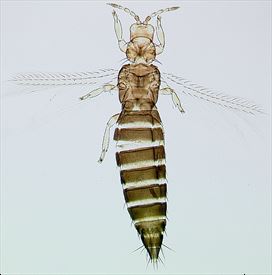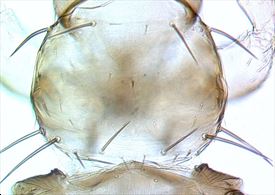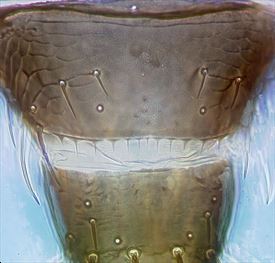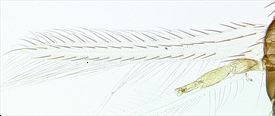Distinguishing features
Both sexes fully winged. Body and legs variable in colour, mainly brown with head and pronotum often paler than abdomen, tibiae and tarsi largely yellow; major setae dark; antennal segments III–IV yellow with apices shaded; fore wing pale with setae dark. Head wider than long; three pairs of ocellar setae present, pair III slightly longer than side of ocellar triangle, arising on anterior margins of triangle; postocular setae pair I present, pair IV short, no longer than diameter of hind ocellus. Antennae 8-segmented; segments III & IV each with sense cone forked, segment VIII as long as VII. Pronotum with 5 pairs of major setae; anteromarginal setae shorter than anteroangulars, one pair of minor setae present medially between posteromarginal submedian setae. Metanotum with 2 pairs of setae at anterior margin, campaniform sensilla absent. Hind coxae with group of microtrichia on dorsal surface. Fore wing with 2 complete rows of veinal setae. Abdominal tergites V–VIII with paired ctenidia, on VIII anterolateral to spiracle; posteromarginal comb on VIII complete, with short slender microtrichia arising from triangular bases. Sternites III–VII without discal setae.
Male smaller and paler than female; tergite VIII with no posteromarginal comb; tergite IX with posterolateral setae stout in larger males; sternites III–VII with transverse pore plate.
Related species
Only two species of Frankliniella are known from New Zealand, F. intonsa and F. occidentalis. These are very similar to each other, but intonsa has the postocular setae considerably shorter than in occidentalis, and lacks campaniform sensilla on the metanotum. Currently 230 species are listed in the genus, with up to 130 further names placed into synonymy (Nakahara, 1997). This high rate of synonymy has been due to unrecognized variability in size and color of so many species. This variability is indicated in common species such as F. intonsa by the large number of synonyms.
Biological data
Breeding on leaves and in flowers, this thrips is recorded from a very wide range of unrelated plant species, with little evidence of any specificity.
Distribution data
Initially, after being introduced into New Zealand in 2002, F. intonsa was recorded only from greenhouse samples in Auckland and Waikato. Today this species is the main pest in many outdoor strawberry crops from Auckland to the Hawke’s Bay and as far south as South Canterbury. It is also a major pest in covered strawberry crops in the wider Auckland region. The species is widespread across the Old World, from western Europe through Iran, northern India, to southern China, Taiwan, Vietnam and Japan. It is also recorded from Panama, USA (Washington State) and Canada (British Columbia and Quebec).
Family name
THRIPIDAE, THRIPINAE
Species name
Frankliniella intonsa (Trybom)
Original name and synonyms
Thrips intonsa Trybom, 1895: 182.
Physopus vulgatissima var. nigropilosa Uzel, 1895: 96.
Physopus vulgatissima var. fulvicornis Uzel, 1895: 96.
Physopus vulgatissima var albicornis Uzel, 1895: 96.
Physopus vulgatissima var. adusta Uzel, 1895: 96.
Thrips pallida Karny, 1907: 49.
Physopus brevistylis Karny, 1908: 278.
Frankliniella breviceps Bagnall, 1911: 2.
Frankliniella vicina Karny, 1922: 94.
Frankliniella intonsa var. maritima Priesner, 1925: 17.
Frankliniella formosae Moulton, 1928: 324.
Frankliniella formosae f. tricolor Moulton, 1928: 325.
Frankliniella intonsa var. rufula Keler, 1936: 104.
Frankliniella intonsa f. norashensis Yakhontov & Jurbanov, 1957: 1279.
References
Hoddle MS, Mound LA, Paris DL (2012) Thrips of California 2012. CBIT Publishing, Queensland. http://keys.lucidcentral.org/keys/v3/thrips_of_california/
Thrips_of_California.html
Nakahara S (1997) Annotated list of the Frankliniella species of the world (Thysanoptera: Thripidae). Contributions on Entomology, International 2: 353–389.
Teulon DAJ & Nielsen MC (2005) Distribution of Western (glasshouse strain) and Intonsa flower thrips in New Zealand. New Zealand Plant Protection 58: 208–212.







